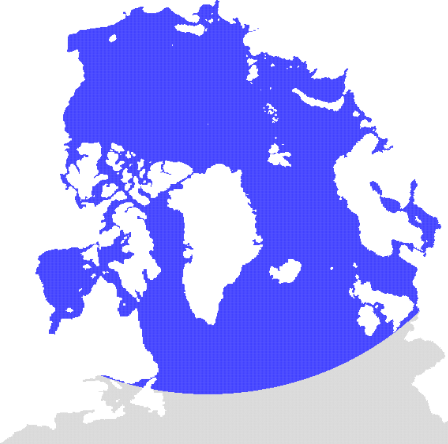Copernicus Marine Arctic MFC PHY_ICE: Validation of thin sea ice
Validation based on satellite data from SMOS
Validation of the Copernicus Marine ARC MFC results for the thickness of thin sea ice is performed using a dataset which is derived from observations from the Soil Moisture and Ocean Salinity (SMOS) satellite. The sea ice thickness data are produced using an emperical algorithm developed by Tian-Kunze et al.. The algorithm takes advantage of data from the microwave radiometer onboard the SMOS satellite. The operational product has been documented by Kaleschke et al..
SMOS data is available during winter, for the period 15 AOctober A- 15 April. SMOS-based results for the thickness of thin ice are available from Alfred Wegener Institute on ftp.awi.de/sea_ice/product/smos/v3.3/nh. SMOS processing was funded by the Support to Science Element Program from ESA.
Processing
We use results for the sea ice thickness and the uncertainty of these data, derived from the SMOS observations. Samples of these two fields are displayed below.

|

|
| SMOS sea ice thickness on 2021-12-01 | Thickness uncertainty on 2021-12-01 |
Before the comparison of model results and SMOS-based observations is performed, we restrict the validation region by requiring that the uncertainty does not exceed either 1 m or 75% of the seaice thickness (see the description of Data quality on the Sea Ice Thickness from L3C SMOS web page).
Next, the sea ice thickness bias and RMS difference between model results and observations are computed. Finally, the thickness distribution is categorized into pre-defined thickness classes, and the model/observation category match-up is displayed in contingency tables.
Region

|
The present version of the coupled sea ice and ocean circulation model used in Copernicus Marine Arctic MFC covers the Arctic Ocean, the North Atlantic Ocean and adjacent ocean regions. The northern part is depicted in the figure to the left. Validation of sea ice thickness from model results is performed for the domain indicated by the blue region in the figure. Note that the actual region for which the validation is performed varies from day to day due to limitations in the geographical coverage, and also due the screening of data resulting from regionally high estimated uncertainty in the observational product. Finally, the temporal observational coverage is restricted seasonally. SMOS data are provided for the freeze-up season since the SMOS data poorly reproduce the sea ice thickness in the melting season. CryoSat data are discontinued during the season when meltponds affect the data. Thus, essentially, both products are available during winter, and not available during summer. |
ARC-MFC PHY_ICE (neXtSIM)
The model results are produced with the neXtSIM stand-alone sea ice model running the Brittle-Bingham-Maxwell sea ice rheology on an adaptive triangular mesh of 10 km average cell length. neXtSIM is forced with surface atmosphere forcings from ECMWF and ocean forcings from the ARC-MFC PHYS NRT system. neXtSIM runs daily, assimilating OSI-SAF sea ice concentrations (SSMI and AMSR2) from the SI TAC and provides 9 day forecasts. The adaptive Lagrangian mesh is interpolated for convenience onto a 3 km resolution regular grid in a Polar Stereographic projection.
